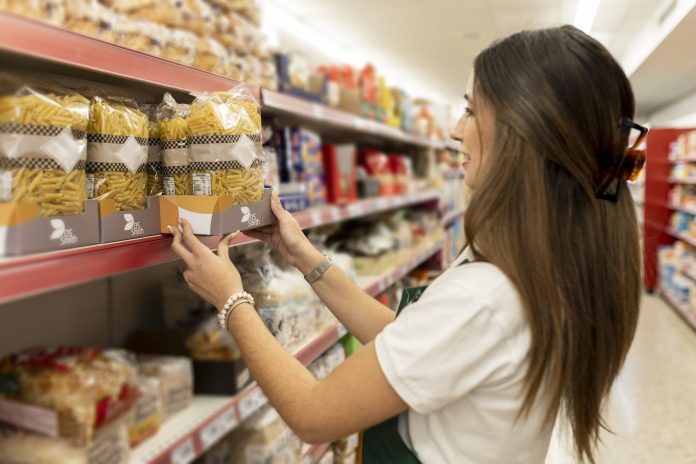From supply chain to shelf: DS Smith Managing Director, Paul Clarke, examines the business impact of smart packaging
Whilst we are only a few months into 2025, there are already plenty of developments for retailers to grapple with.
Although UK inflation unexpectedly dipped in December, UK shoppers are bracing for another hit to their wallets, as food prices are predicted to surge by nearly five percent this year.
73 percent of UK consumers are “worried” about the high cost of living, with only eight percent planning on increasing their spending. In fact, 72 percent of consumers now wait for a special shopping event to make a purchase.
This means that businesses are having to work harder than ever to capture shoppers’ attention – whether that’s in store or online. All the while, aiming to run as efficiently as possible and cut unnecessary costs.
So, what role can packaging play in all of this? There are several ways that brands of all sizes can use it to their advantage and unlock additional value that can give a boost to their business.
Build a stronger presence within retail
The instore shopping experience gives shoppers the opportunity to experience the products in front of them in a way that isn’t possible online.
According to a survey conducted by Mood Media, 82 percent of consumers say that seeing, holding, or demoing a product in-person makes them more likely to buy it. This set of behaviours means brands need to work harder with their packaging, creating messaging that helps them stand out from the crowd.

Here, Point of Sale plays a crucial role as a creative and often playful medium to display products. It is a way to connect the dots with secondary packaging, through premium textures, sustainable materials, and interactive design using off shelf displays.
For instance, when Pepsi launched an exciting new Mango flavour to its existing range of Pepsi MAX drinks, DS Smith was tasked with designing an attention-grabbing display which would tempt shoppers to give it a try. By using the contrast of Pepsi’s brand colours against sprinkles of bright yellow, the unit embodied the refreshing flavour and grabbed busy shoppers’ attention (below).

The header at the top of the display reiterated to them that it was their chance to discover the brand-new flavour, raising excitement around the product launch, and supported retailers with their price promotion offering.
Nailing the in-store messaging and design emphasised the value and the unique selling points of the product. This therefore presented the brand with a unique opportunity to engage with shoppers and encourage them to make a sale.
Enhance the shopper experience
Over the past couple of years, the way consumers shop has transformed dramatically. In the UK, internet sales now represent over 27 percent of retail sales, with over 80 percent of the population engaging in e-commerce purchases. This shift places immense pressure on businesses to bridge the gap between digital and physical touchpoints. At DS Smith, we are helping our customers enhance their online shopper experience with solutions that make the right first impression for their brand, from a unique unboxing experience to enhanced personalisation and product protection.
We’ve been working with Oceans – one of the first UK manufacturers to offer plastic-free toilet tissue and kitchen towels – to launch a sustainable, forward-thinking packaging solution for its toilet paper. The brand wanted to design a range of introductory packs which would encourage customers to make use of its subscription offer for toilet roll, safe in the knowledge that the packaging was plastic-free and 100 percent recyclable.
After a rigorous design process and testing, the finished box was made from 100 percent recyclable content, with modified dimensions to cut down on waste and space. To maximise customer experience when opening the box, the design featured an introduction to the brand, Oceans messaging and a QR code with details on how first-time customers could get 10 percent off on the next Oceans order. As a result, Oceans saw over half of customers make a repeat order online or make another purchase at the same time as the trial purchase.

Packaging therefore has a unique role to play in connecting with shoppers on an emotional level, connecting to the physical world through mobile devices, QR codes, coupons, and competitions.
Improve operational efficacy
Packaging isn’t just about creating an aesthetically pleasing brand design which meets the necessary functional requirements, but one that factors in logistics and fulfilment. Doing so can have a tangible impact on the operational efficacy of a business, and in turn, its bottom line.
DS Smith has firsthand experience of this through our work with Goodrays, a London-based start-up specialising in CBD drinks. The unique, easier-to-fold bespoke design we created for the brand (below) resulted in an estimated carbon footprint reduction of up to 20 percent.

The changes mean that more product can be loaded into a van – up to four times more – resulting in less trips to suppliers and a reduction in travel. Made from 100 percent recyclable content, the finished design also has a reduced thickness, further saving on materials.
At the other end of the scale, we helped global snacking company pladis to reduce plastic in its iconic orange Jacob’s Cream Crackers box. With plastic reduction increasingly becoming front of mind for retailers and demanded by consumers, pladis approached DS Smith about creating new packaging for the iconic Jacob’s Crackers Selection pack, which minimised the amount of plastic waste in the shell of the packaging, while retaining the tamper proof seal. After rigorous testing by DS Smith designers, the finished product (below) featured 78 percent less plastic per pack, saving over 373,248kg of CO2. All the while incorporating high quality print to the same standard as the previous solution.

It’s these changes to the packaging design which can all add up to a sizeable difference for a business, whatever its size.
Conclusion
Packaging is one of the many core facets making up a business, but its impact shouldn’t be underestimated. Whether it is helping to create a stronger presence at retail, enhancing the shopper experience or improving operational efficiency, it has a powerful role to play in helping brands unlock additional value in what continues to be a challenging economic environment.




